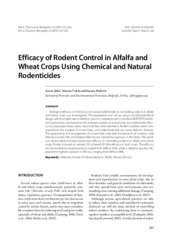Приказ основних података о документу
Efekti suzbijanja glodara u usevima lucerke i pšenice primenom rodenticida hemijskog i prirodnog porekla
Efficacy of rodent control in alfalfa and wheat crops using chemical and natural rodenticides
| dc.creator | Jokić, Goran | |
| dc.creator | Vukša, Marina | |
| dc.creator | Đedović, Suzana | |
| dc.date.accessioned | 2023-01-10T14:54:34Z | |
| dc.date.available | 2023-01-10T14:54:34Z | |
| dc.date.issued | 2007 | |
| dc.identifier.issn | 1820-3949 | |
| dc.identifier.uri | https://ripest.pesting.org.rs/handle/123456789/44 | |
| dc.description.abstract | Ispitivana je biološka efikasnost rodenticida prirodnog i hemijskog porekla za suzbijanje glodara u usevima lucerke i pšenice. Eksperimenti su izvedeni prema standardnoj metodi OEPP/EPPO. Ogled je postavljen po potpuno slučajnom blok sistemu, sa četiri ponavljanja i veličinom osnovne parcele od 400 m2. Obeležja koja su praćena tokom ovog ispitivanja su prosečna brojnost aktivnih rupa i efikasnost rodenticida u vremenu od tri, sedam, 14 i 28 dana. Brojnost glodara je izračunata na osnovu broja aktivnih rupa, a efikasnost rodenticida prema Abbott-ovoj formuli. Na osnovu izgleda i prostornog rasporeda aktivnih rupa utvrđeno je prisustvo poljske voluharice (Microtus arvalis Pall) i poljskog miša (Apodemus agrarius) na eksperimentalnim parcelama. Testirani preparati pokazali su zadovoljavajuću efikasnost u suzbijanju glodara u usevima lucerke i pšenice. Preparati na bazi vitamina D3, u oba useva, pokazali su efikasnost 87-90%. Efikasnost preparata na bazi bromadiolona bila je u intervalu 84-90%, dok je preparat na bazi celuloze pokazao najveće oscilacije i njegova efikasnost je bila u intervalu 86-98%. | sr |
| dc.description.abstract | Biological efficacy of chemical and natural rodenticides in controlling rodents in alfalfa and wheat crops was investigated. The experiment was set up using a randomized block design with four replicates and 400 m2 plots in compliance with a standard OEPP/EPPO method. Examination was based on the average number of active holes and rodenticide efficacy was measured three, seven, 14 and 28 days after treatment. Rodent numbers were computed from the number of active holes, and rodenticide efficacy using Abbott’s formula. The appearance and arrangement of active holes indicated the presence of common vole (Microtus arvalis Pall) and striped field mouse (Apodemus agrarius) in the plots. The products tested demonstrated satisfactory efficacy in controlling rodents in alfalfa and wheat crops. Products based on vitamin D3 achieved 87-90% efficacy in both crops. The efficacy of a bromadiolone-based product ranged from 84% to 90%, while a cellulose product displayed the highest variation in efficacy, ranging from 86% to 98%. | en |
| dc.publisher | Institut za pesticide i zaštitu životne sredine, Beograd i Društvo za zaštitu bilja Srbije, Beograd | |
| dc.rights | openAccess | |
| dc.rights.uri | https://creativecommons.org/licenses/by-sa/4.0/ | |
| dc.source | Pesticidi i fitomedicina | |
| dc.subject | vitamin D3 | sr |
| dc.subject | pšenica | sr |
| dc.subject | lucerka | sr |
| dc.subject | efikasnost | sr |
| dc.subject | celuloza | sr |
| dc.subject | bromadiolon | sr |
| dc.subject | wheat | en |
| dc.subject | vitamin D3 | en |
| dc.subject | efficacy | en |
| dc.subject | cellulose | en |
| dc.subject | bromadiolone | en |
| dc.subject | alfalfa | en |
| dc.title | Efekti suzbijanja glodara u usevima lucerke i pšenice primenom rodenticida hemijskog i prirodnog porekla | sr |
| dc.title | Efficacy of rodent control in alfalfa and wheat crops using chemical and natural rodenticides | en |
| dc.type | article | |
| dc.rights.license | BY-SA | |
| dc.citation.epage | 246 | |
| dc.citation.issue | 3 | |
| dc.citation.other | 22(3): 241-246 | |
| dc.citation.spage | 241 | |
| dc.citation.volume | 22 | |
| dc.identifier.fulltext | https://ripest.pesting.org.rs//bitstream/id/278/41.pdf | |
| dc.identifier.rcub | conv_31 | |
| dc.type.version | publishedVersion |

